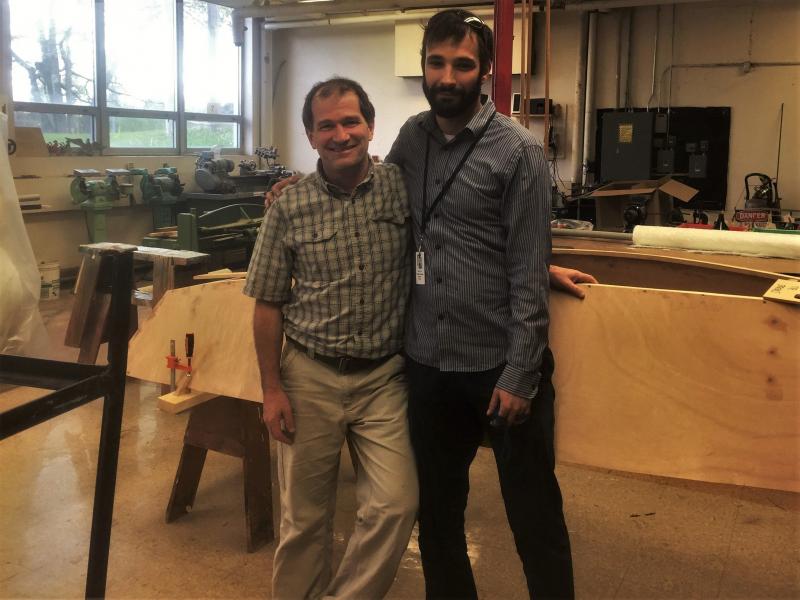Boothbay Region High School teachers Chip Schwehm and Chris Liberti, with help from former technology integrator Barbara Greenstone, have been working on a new proficiency-based portfolio system. It would help students identify their growth over four years in five key areas: clear and effective communication, collaboration and quality, integrative and informed thinking, creative and practical problem-solving, and responsible and involved community service.
The system the three teachers are proposing differs from the proficiency-based diploma the state has been wavering over for the past year. Schwehm and Liberti understood the state’s standards for proficiency to involve problems and problem-solving like "solving systems of linear equations in two variables using the elimination method, Liberti said.
"That level of detail is I think what proficiency was aiming at,” said Schwehm. “This portfolio isn't going there. It's much more general."
The portfolios will give students the opportunity to enter various media of work including written, audio and video which will help blur the lines between subjects and disciplines. It will allow students who struggle in one class to illustrate their growth and knowledge about a subject by methods learned in other classes.
Said Liberti, “… Just because you're potentially not doing too well in English, it might not have anything to do with how well you can write or how well you can present. That might be a separate thing and I think it helps kids see that. It's not designed to be punitive and it's not designed to be a hundred hoops to jump through.”
When the New England Association of Schools and Colleges (NEASC) last came through for BRHS's accreditation, the school was asked how it was evaluating these broad areas, said Schwehm. "We're not. This gets at that. This will satisfy our accreditation, that we are actually looking at those big picture skills."
"They're all broad things that we've never really done a good job at assessing for kids. Nobody's ever taken a look at problem-solving and had to give kids repeated attempts to solve problems that are open-ended, that have multiple possible solutions. We're kind of using it to go after some things we've never gone after … that are large in scope and cross all the disciplines – and that's kind of exciting."
Liberti called the portfolios a “carrot” as opposed to a “whip” and a reason for students to continue moving forward and identify value in their work. What it is not, said Liberti, is a means to prevent students from graduating when they do not hit specific targets, and is very much what the state is proposing.
Asked what the teachers expect from the system if it is implemented, Schwehm said it will live up to NEASC accreditation through the five broad goal areas, which are important.
“I think really, really key is having kids reflect on four years of school which is something we don't ask them to do at all," Schwehm added.
Additionally, teachers who provide a study hall-like period for their advisees do not often get the opportunity to speak with students, one on one, as often as they would like. This would give the academic advisors room to speak with students about the classes they have with them, and the students' work in other classes. The perspective, say, a math teacher can give to a student struggling in English can be valuable and visa versa, said Liberti.
Schwehm said this system will also help bring faculty together to have serious conversations about students' strengths and weaknesses; communication between teachers is just as important as communication with students.
"Hopefully a couple Wednesdays a month, we'll sit down and work with our advisees ... and see what other teachers are doing and talk about work," said Schwehm. "Hopefully that's a unifying thing with the faculty … We're very isolated and we really don't know the nitty-gritty about what goes on in other peoples' classes … so (if) we really see what other people do and start to value it, (we’ll) start to see the school more as a whole."
Liberti hopes it can get future projects off the ground. For example, Liberti said, if one class is exploring the stock market mathematically and another historically, with better communication, teachers could tie material into each other's classes.
Both teachers said one of the only changes they would make to the proposed standards is the name. They both recognize how hard a sell “proficiency-anything” is in the current political and educational climate.
"There's just so much attached to that," said Schwehm. "… It's more of a growth portfolio and reflective portfolio, so it looks back on the four years for what they've done as a problem solver as a communicator, pick out good examples of work and talk about how they grew, not necessarily how they've reached a certain level.”
Liberti said that, ultimately, when a graduate goes into a job interview and is asked how the employer knows they can be flexible and be able to solve problems, the graduate can give comprehensive examples.
Said Schwehm, "If a kid has demonstrated all of that stuff in a portfolio presentation, they could take that somewhere I think."



























